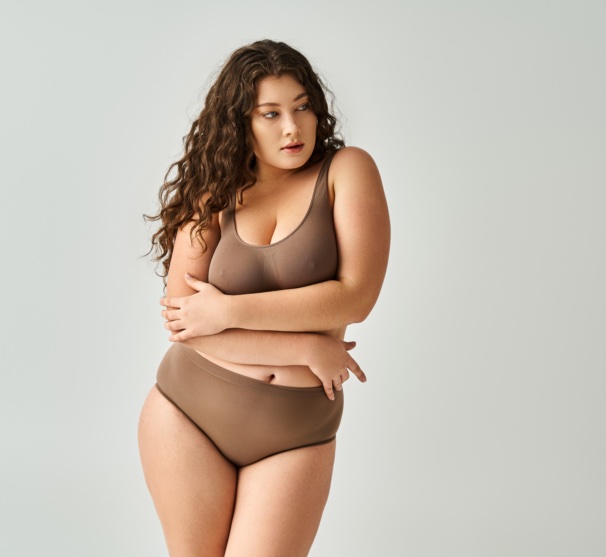
“Ozempic® breasts” refers to sagging or volume loss in the breasts after significant weight loss from medications like Ozempic®, Wegovy®, or Zepbound™. These changes are caused by reduced fat and stretched skin, not the medication itself. Procedures such as a breast lift, augmentation, or fat grafting can restore a firmer, more youthful shape.
The rise of weight loss injections like Ozempic®, Wegovy®, and Zepbound™ has helped countless people improve their health, confidence, and quality of life. However, one topic that’s recently gained attention online is the physical change some patients notice after significant weight loss — particularly in the breasts. Commonly referred to as “Ozempic® breasts,” this term describes the deflated or sagging appearance that can occur after rapid or substantial weight reduction.
While the nickname may sound new, the underlying cause isn’t unique to medication-related weight loss. Any time the body loses fat quickly, breast tissue, which is composed largely of fat and glandular tissue, can lose volume and elasticity. Below, Dr. Neil Zemmel, our board-certified plastic surgeon in Richmond, VA, explains what causes these changes and what can be done to restore a firmer, more youthful breast contour.
What Causes “Ozempic® Breasts”?
When someone loses a significant amount of weight, whether through lifestyle changes, bariatric surgery, or GLP-1 medications like Ozempic®, Wegovy®, or Zepbound™, the breasts often shrink in size. Because the skin and supportive ligaments don’t always contract at the same rate as the underlying fat loss, the result can be loose, stretched skin and a flatter or drooping appearance.
Other factors, such as age, genetics, pregnancy, breastfeeding, and natural collagen decline, can amplify this effect. The degree of sagging (known medically as ptosis) varies widely from person to person. Some individuals simply lose volume, while others experience more pronounced changes in shape and firmness.
It’s important to understand that these effects are not harmful or directly caused by the medication itself. Instead, they’re a natural response to the body’s changes in fat distribution and skin elasticity during weight loss.
Can “Ozempic® Breasts” Be Prevented?
While it’s not always possible to prevent loose skin entirely, certain measures can help minimize the appearance of sagging:
- Gradual weight loss allows the skin more time to adapt to the body’s new contours.
- Strength training can help tone the underlying chest muscles, providing mild lift and support.
- Hydration, a nutrient-rich diet, and consistent skincare may improve skin elasticity over time.
Even with these steps, some degree of looseness may still occur, especially after major weight loss. When that happens, surgical or non-surgical options may be considered to restore shape and volume.
Surgical Options to Restore Breast Shape After Weight Loss
Dr. Neil Zemmel offers a range of breast enhancement procedures that can help address sagging, volume loss, and asymmetry after weight loss from medications like Ozempic®, Wegovy®, or Zepbound™. The ideal approach depends on the amount of tissue loss, the position of the breasts, and the patient’s overall goals.
1. Breast Lift (Mastopexy)
A breast lift tightens stretched skin and repositions the breast tissue higher on the chest for a more youthful contour. The procedure can also restore projection and correct downward-facing nipples. Many patients who have lost weight find that a lift alone provides a beautifully natural result, even without implants.
2. Breast Augmentation
For patients who have lost significant volume, breast augmentation using implants or fat transfer can restore fullness and upper pole roundness. Dr. Zemmel offers a variety of implant options as well as fat transfer using a patient’s own tissue for a subtle, natural look. In some cases, a breast lift with implants may provide the best outcome by both lifting and enhancing size.
3. Breast Reduction
Some individuals experience sagging with remaining excess breast tissue, which can lead to discomfort or imbalance after weight loss. A breast reduction can remove excess tissue while lifting and reshaping the breasts for a proportionate, rejuvenated result.
4. AlloClae™ Structural Fat Grafting
Richmond Aesthetic Surgery also offers AlloClae™, an advanced technique that uses structural fat grafting to restore natural shape and fullness. This can be an excellent option for patients who want to enhance their breast volume without traditional implants, especially after weight fluctuations.
The Importance of a Personalized Approach
Every patient’s experience with post-weight loss body changes is different. During a consultation at Richmond Aesthetic Surgery, Dr. Zemmel performs a detailed evaluation to assess breast tissue quality, skin elasticity, and overall proportions. From there, he develops a customized treatment plan that aligns with the patient’s anatomy, lifestyle, and cosmetic goals.
Patients who have achieved weight loss through GLP-1 medications are often encouraged to maintain a stable weight for several months before undergoing surgery to ensure the best long-term results. This allows the skin and tissues to settle and ensures the chosen procedure will provide lasting, natural-looking improvement.
Empowering Confidence at Every Stage
The goal of weight loss, whether achieved through Ozempic®, Wegovy®, Zepbound™, or lifestyle changes, is to feel healthier and more confident. For many, breast enhancement surgery is the final step in that transformation, helping the body’s appearance reflect the hard work and dedication that led to the change.
Dr. Zemmel and his team at Richmond Aesthetic Surgery are experienced in post-weight-loss body contouring and are dedicated to helping patients look and feel their best at every stage of their journey. Whether you’re seeking to lift, enhance, or reshape your breasts after significant weight loss, you can expect compassionate care, personalized guidance, and beautiful, natural results.
Previous Post